Services on Demand
Journal
Article
Indicators
Related links
-
 Cited by Google
Cited by Google -
 Similars in Google
Similars in Google
Share
Acta Structilia
On-line version ISSN 2415-0487Print version ISSN 1023-0564
Acta structilia (Online) vol.31 n.2 Bloemfontein 2024
https://doi.org/10.38140/as.v31i2.8154
RESEARCH ARTICLE
The efficacy of roof-based adaptations to reduce heat stress exposure in informal dwellings
Ethan ViljoenI; Jan HugoII, *
IDepartment of Architecture, University of Pretoria. Email: <ethan.viljoenza@gmail.com>, ORCID: https://orcid.org/0009-0001-8150-6358
IISenior Lecturer, Course Coordinator Professional Masters Programme; Earth Sciences Department of Architecture, University of Pretoria. Email: <jan.hugo@up.ac.za>, ORCID: https://orcid.org/0000-0003-4840-2642
ABSTRACT
While climate change represents a universal threat to the sustainable growth efforts globally, its impacts are not experienced equally with marginalised population groups, especially informal settlement residents, being highly exposed to its negative effects. Despite being widely acknowledged that the built environment is a major driver of inhabitants' exposure to climate change-related hazards, limited research has been undertaken on developing heat stress adaptation measures for informal settlements in Southern Africa. Furthermore, Africa's projected rapid urbanisation and limited adequate housing provision point to a significant growth of informal settlements, particularly within the Southern African context. The dearth of available information on household level climate change adaptation in informal settlements prompted this study to investigate the efficacy of roof-based adaptation strategies to lower heat stress exposure in informal dwellings in Tshwane, South Africa. As an explorative study with a quantitative focus, the study uses a digital simulation research design to assess the efficacy of four climate change adaptation strategies to lower heat stress exposure in two typical informal dwellings as case studies. While informal settlements have diverse building typologies, informal dwellings - frame structures cladded with steel sheeting without any thermal insulation - are widely used and highly vulnerable. In contrast to typical adaptation measures proposed for informal dwellings, the main findings highlight the benefit of high thermal mass coupled with shading strategies to lower thermal amplitudes and lower excessive heat stress exposure. Consequently, the article contributes to the current climate change adaptation discourse, in particular its application in informal settlements.
Keywords: informal settlements, climate change adaptation, thermal comfort, heat stress, thermal simulation
ABSTRAK
Terwyl klimaatsverandering 'n wêreldwye bedreiging vir volhoubare ontwikkeling inhou, word die impakte daarvan nie gelykmatig ervaar nie, met sommige bevolkingsgroepe, soos die wat in informele nedersettings bly, wat aansienlik meer blootgestel is aan die negatiewe impakte van klimaatsverandering. Alhoewel dit alombekend is dat die bou omgewing 'n bepalende faktor speel in terme van die blootstelling van inwoners aan klimaatsverandering-verwante gevare en direkte implikasies het op hul gesondheid en welstand, is daar min navorsing beskikbaar oor klimaatsverandering aanpassingstrategieë vir informele nedersettings. Verder, as gevolg van vinnige verstedeliking van Afrika en die beperkte bekostigbare behuisingsopsies wat beskikbaar is, word verwag dat die bevolkingsgetalle van toekomstige stadbewoners wat in informele toestande woon, sal toeneem, veral in Suider-Afrika. As gevolg van die min beskikbare inligting en die verwagte groei van informele nedersettings het hierdie studie ten doel om die doeltreffendheid van dak-gebaseerde aanpassingstrategieë te ontwikkel en ondersoek om die hittelas blootstelling in informele behuisings in Tshwane, Suid-Afrika, te verlaag. As 'n navorsingstudie met 'n kwantitatiewe fokus, gebruik hierdie studie 'n digitale simulasie navorsingsontwerp om die doeltreffendheid van vier klimaatsverandering aanpassingstrategieë te beoordeel om hitte las blootstelling in twee tipiese informele huise met swak termiese gedrag as gevallestudies te verlaag. In teenstelling met tipiese aanpassingstrategieë wat vir informele behuisings voorgestel word, beklemtoon die bevindinge die voordeel van hoë termiese massa-oplossings saam met sonbeheer om die termiese amplitude te verlaag en buitensporige hitte las blootstelling te verminder. Gevolglik dra die artikel by tot die huidige klimaatsverandering aanpassingsteorie, veral die toepassing daarvan in informele nedersettings.
1. INTRODUCTION
Climate change represents a threat to worldwide sustainable development and growth (Morton, Pencheon & Squires, 2017). However, it cannot be viewed in isolation from other socio-economic and environmental challenges affecting communities, which are often exacerbated by the effects of climate change (CSIR, 2019). The impacts of climate change such as increased global average temperatures are highly variable and geographically specific. These impacts are experienced differently and unequally on a local scale (IPCC, 2022; Seto & Shepherd, 2009). The built environment fundamentally shapes the experience, vulnerability, and relative exposure of its users to climate change (IPCC, 2022), highlighting the importance of adapting our cities to impending climate change impacts.
Among a range of impacts, climate change is expected to increase global mean ambient temperatures as well as the frequency and intensity of droughts and heatwaves (Conradie, 2017). Within the South African interior, mean ambient temperatures are estimated to increase by between 4°C to 6°C by 2100, should limited global climate change mitigation strategies be implemented (Cherich & Wright, 2019). This rise in temperature is expected to increase the number of heatwave-classified days in South Africa by between 20 to 80 days annually (Kapwata et al., 2018). Resulting in prolonged heat stress exposure that leads not only to discomfort but also to physiological impacts such as heatstroke, fainting, and even death (Kapwata et al., 2018).
The relationship between the quality of the local built environment and the health and well-being of its users is an important nexus of inquiry, which has been well documented and formed the basis for a large body of research (Naicker et al., 2017). On the other hand, hardly any research has thus far been undertaken to address climate change adaptation, in particular to heat stress exposure impacts within informal contexts (Bek, Azmy & Elkafrawy, 2018; Hugo & Sonnendecker, 2023; Ncongwane et al., 2021; Okyere & Kita, 2015). With the increasing risk of extreme weather conditions, driven by climate change, understanding and improving the health and well-being and built environment nexus is increasingly important - particularly in informal contexts (Satterthwaite et al., 2020).
As the informal built environment received limited attention in terms of its climate change readiness, the Architecture and Public Health Nexus project (undertaken from 2020 to 2023) is an interdisciplinary project implemented in the Melusi informal settlement in Tshwane, South Africa. This research project explored developing climate change adaptation strategies that improve poorly insulated structures that experience overhead solar exposure, due to the low-to-mid latitudinal location and the extensive direct irradiation levels of the study region (SolarGIS, 2024). In this context, retrofitting dwelling roofs present leverage potential (Conradie, 2017). To date, roof-based climate change adaptation strategies applied to informal settlements have received limited attention. This article reports on a sub-study undertaken in this research project that considered roof-based adaptations, as non-intrusive adaptation measures to lower heat stress exposure in informal settlements in Southern Africa.
The article builds on the existing research that advocates increasing envelope albedo rates (Kimemia et al., 2020; Nutkiewicz et al., 2022). However, it noted the limited consideration into using thermal mass, a heat stress amelioration strategy. Although the successful use of double roof construction methods has been reported in precedents in North Africa (Kere, 2012), its application in the Southern African context is yet to be explored. As a result, the study considered using improved solar reflection, additional shading, and increased thermal mass to improve the climate change adaptation potential of roof-based adaptations.
2. LITERATURE REVIEW
While climate change is often considered to be a global phenomenon, there has been progress in translating the effects of climate change into understanding its local impacts. The Greenbook (CSIR, 2019) is one such report identifying specific vulnerabilities and plans of action to achieve sustainable development on municipal scales. Within the local Tshwane context, two predominant threats need to be addressed, namely planning for extensive urbanisation across the region, and increases in heat-related health concerns, due to higher than global average temperature increases expected for the region (CSIR, 2019; DEA 2013). These two issues exhibit a high degree of negative interactivity, often manifesting within the built environment (Seto & Shepherd, 2009) and particularly in informal urban contexts (Hugo & Sonnendecker, 2023).
2.1 Informality as a response to rapid urbanisation
Global population growth and urbanisation lead to an increase in growth pressure on urban environments, particularly in Africa (Pieterse, 2011; Satterthwaite et al., 2020). Informal settlements, which house at least one billion people worldwide (Satterthwaite et al., 2020), have developed as a response to this growth pressure coupled with an insufficient capacity to provide appropriate and affordable housing solutions to the urban poor (Nutkiewics et al., 2022).
Across the African continent, informality has emerged as the dominant mechanism for urbanisation, surpassing all other development forms (Okyere & Kita, 2015). In 2011, it was estimated that 62% of urban residents in Africa lived in informal settlements (Pieterse, 2011). More recent data suggests that informality accounts for 30% to 50% of the population in many cities within developing contexts (Satterthwaite et al., 2020). In some African cities such as Dar es Salaam, as much as 70% of the population resides in informal settings (Satterthwaite et al., 2020). Although the level of informality is lower in South Africa, where it comprises 11% of the urban population (Naicker et al., 2017), it still represents a significant portion of the population. Thus, informal growth poses both an immediate and escalating challenge to sustainable development efforts and to mitigating urban climate change vulnerabilities (Nutkiewics et al., 2022; Okyere & Kita, 2015). One pressing climate hazard requiring urgent attention is heat stress exposure.
2.2 Heat stress in the urban environment
Populations residing within urban areas are increasingly vulnerable to the effects of higher temperatures and the increased occurrence of high heat events brought about by climate change (Naicker et al., 2017). This is further exacerbated by the material, spatial, and atmospheric nature of cities, resulting in a high prevalence of the urban heat island effect (UHI) (Bek et al., 2018; Conradie, 2017).
The UHI phenomenon can cause daytime temperature increases of up to 3°C in urban areas, compared to surrounding rural regions (Bek et al., 2018). UHI primarily arises from higher population densities, elevated energy consumption, and the heat-retaining properties of materials and construction methods used in urban settings (Conradie, 2017). These temperature increases, coupled with the rising temperatures driven by climate change, have significant implications for the health and well-being of residents.
Globally, urban environments accommodate roughly half of the population, which is expected to increase to 70% by 2050 (Seto & Shepherd, 2009). As result, the geometry, material choices, and thermal properties of the urban built fabric will play a definitive role in the ability of communities to deal with higher temperatures, due to climate change and the UHI impacts (Bek et al., 2018; Nutkiewics et al., 2022; Seto & Shepherd, 2009). Ultimately, these choices are also noted to affect the heat stress exposure of informal settlement residents, as these environments are often characterised by lower vegetation coverage, limited resources and service provision, and higher population densities (Dodman, Archer & Satterthwaite, 2019).
2.3 Health implications of heat stress on urban residents
Urban residents encounter a range of thermal conditions both indoors and outdoors, which can have various effects on their well-being (Naicker et al., 2017). Typically, an individual maintains a resting body temperature of between 36°C and 37°C and relies on thermoregulation to achieve homeostasis during temperature changes (Kovats & Hajat, 2007). This temperature can vary slightly among individuals and may also fluctuate throughout the day based on activity levels or exposure to heat.
However, long-term exposure to excessively high temperatures can have lasting negative effects on one's health and well-being (Kovats & Hajat, 2007). Prolonged exposure to temperatures above 40°C has been linked to symptoms including sunburn, insomnia, exhaustion, muscle cramps, mood fluctuations, difficulty concentrating, and reduction in cognisance (Baruti & Johansson, 2020; Cherich & Wright, 2019). At higher temperatures, coupled with long-term exposure, further symptoms associated with heatstroke begin to emerge, including dehydration and fainting (Kapwata et al., 2018). Lastly, heat stress has been linked to mortality in several instances worldwide (Cherich & Wright, 2019).
2.4 Quantifying the heat stress exposure of residents
Air temperature in isolation does not necessarily reflect a user's experience of temperature within a given environment accurately (Orimoloye et al., 2017). Therefore, various thermal metrics such as the Heat Index (HI), Humidex or Predicted Mean Vote (PMV) are used (Blazejczyk, Jendritzky & Bröde, 2013). These metrics include and account for the impacts of various other meteorological parameters on the lived experience of users including, among others, relative humidity, wind speed, and mean radiation temperatures to calculate an adjusted value reflecting users' thermal experience (Blazejczyk et al., 2013).
This adjusted value can often be analysed against an appropriate index relative to the thermal metric used, which indicates varying levels of expected risk or comfort prescribed to different temperature ranges (Blazejczyk et al., 2013). This process allows one to quantify and assess the associated user comfort or risk expected to accompany various ranges of temperatures. However, the concept of 'thermal comfort' is often subjective, as reported by built environment's users (Nutkiewics et al., 2022). Perceived thermal comfort differs in terms of climate, context, activity, and users (Santos Nouri & Predo Costa, 2017). Importantly, the concept of 'adaptive thermal comfort', as proposed by Brager and De Dear (1998), emphasises that thermal comfort is influenced by past thermal experiences, non-thermal factors, and the thermal expectations of occupants. Thus, thermal comfort is highly contextual and subjective.
Although thermal comfort exhibits complex, subjective, and user-specific variations, the literature generally agrees on specific temperature thresholds associated with objective health impacts related to heat stress exposure (Kovats & Hajat, 2007), as discussed in the methods section (Section 4.3). This article specifically concentrates on heat stress exposure, due to its potential future risks for urban residents.
2.5 Implications of heat stress on informal settlement residents
Climate change is expected to increase ambient temperatures that will increase daily heat stress exposure and the number of annual heatwave events. As a result, inhabitants of informal settlements are expected to experience elevated levels of heat stress exposure (Hugo & Sonnendecker, 2023). These amplified levels of heat stress exposure are not only driven by climate change itself, but also by the material and land-use choices during the development of informal settlements.
Despite their diversity in form and nature, informal urban areas share several characteristics that heighten their vulnerability to climate change (Okyere & Kita, 2015). As noted by Dovey (2015: 6), informal growth often occurs on "interstitial and marginally used" land. These settlements typically do not adhere to established planning and construction regulations within the built environment (Okyere & Kita, 2015). Moreover, the rapid expansion of informal settlements often results in limited land tenure, inadequate services and infrastructure, and insufficient public space (Hernandez-Garcia, 2013; Satterthwaite et al., 2020). Residents in these areas frequently face a lower quality of life and restricted access to essential resources and infrastructure (Dovey, 2015; Nutkiewics et al., 2022; Pieterse, 2011). This limited access to resources is further intensified by the high population density in these settlements (Bek et al., 2018). In addition, the locations and urban forms of informal settlements often expose them to significant risks from precipitation-driven flooding and fires (Satterthwaite et al., 2020).
In the context of heat stress exposure, dwellings and structures in informal settings often lack adequate insulation, solar control, and ventilation. As a result, these buildings are susceptible to extreme heat during the day and can become excessively cold at night (Naicker et al., 2017; Hugo & Sonnendecker, 2023). These temperature extremes and prolonged exposure have direct implications for the health of residents (Naicker et al., 2017). To effectively address these adverse conditions in informal contexts, modifications to the built environment are necessary.
2.6 Heat stress response measures undertaken in informal settlements
In light of the significant exposure and vulnerability levels observed in informal settlements, several research initiatives have concentrated on developing measures to enhance the indoor environments of these homes. These studies have explored strategies such as improved ventilation, enhanced solar shading, and increasing the albedo of building envelopes.
Improving ventilation rates has been investigated as a method for reducing high indoor temperatures. These are often used in conjunction with higher thermal mass such as the use of traditional Shisha clay funnels as ventilation screens in informal dwellings (Dabaieh, Zakaria & Kazem, 2021). Dabaieh et al. (2021: 6) found that these systems can lower indoor temperatures by 2°C. Similarly, Ayanlade et al. (2019) evaluated the effectiveness of louvre screens in enhancing ventilation and reducing indoor temperatures. Their findings indicated that louvre windows provide greater thermal comfort compared to sliding windows.
Konstantoglou and Tsangrassoulis (2016) conducted a review of dynamic shading systems and discussed the use of adaptive external shading devices that provide shade in summer while allowing solar gain in winter. Their review highlights energy use benefits but also conclude that these systems are complex to install and maintain (Konstantoglou & Tsangrassoulis, 2016). The benefits of such successful shading systems are notable with up to a 63% energy reduction in cooling loads reported in a study conducted in the dry mediterranean climate (Perez-Carramiñana et al., 2024: 16).
Kolokotroni et al. (2018), Kimemia et al. (2020), and Nutkiewicz et al. (2022) considered the use of cool roof paints to lower radiative thermal transfer. Nutkiewicz et al. (2022) concluded, from simulations of informal dwellings in various cities, that modifying the building envelope has significant potential to enhance the indoor environment. Kimemia et al. (2020: 33) simulated the use of cool roof paints as an adaptation strategy for informal dwellings in South Africa, finding that these paints can reduce maximum indoor temperatures by up to 10°C. Similarly, Koloktroni et al. (2018: 68) examined the application of highly reflective paint on poorly insulated, high-mass structures in Ghana, Jamaica, and Brazil, noting a cooling demand reduction of 188kWh/m2/year to 195kWh/m2/year. While highly reflective paints effectively reduce heat stress exposure, there have been reports of over-cooling during winter (Kimemia et al., 2020) and decreased effectiveness over time, due to aging (Koloktroni et al., 2018).
While high thermal mass building materials have been used extensively in architecture, their application as climate change adaptation strategies is not widely explored in the upgrade of informal settlements. Smith (2010) advocates employing high thermal mass building materials to address higher temperatures and climate change hazards, which is similarly promoted in the latest IPCC assessment report (2000). Research into developing double skin roofs coupled with high thermal mass, as noted in the work of Diebedo Francis Kere (2012) in the Gando School in Burkina Faso, is limited. Research by Zingre, Yang & Wan (2017) and Orazio et al. (2010) assessed the use of double skin roof, coupled with high thermal mass in tropical and mediterranean contexts, respectively. While the technological applications are different in both experiments, both reported successfully limiting thermal transfer through the roofs, with Zingre et al. (2017) reporting a 28% to 34% improvement. Recent work by Meng et al. (2022) compared double skin roofs with green roofs and cool roofs concluding that green roofs (high thermal mass resulting from using soil) and double skin roofs are more effective than cool roof applications, both in improving indoor temperatures and removing excess heat through radiation.
The literature review highlights multiple factors contributing to the climate change vulnerability of informal settlement dwellers. This is as a result of the material choices and building strategies that informal residents use, as well as their poor adaptive capacity, due to their socio-economic status. Informal urban areas also portray a high degree of heat stress exposure, associated with the local UHI effects (Bek et al., 2018; IPCC, 2022; Naicker et al., 2017; Nutkiewics et al., 2022). On the other hand, several studies considered potential response measures, but limited work assessed roof-based adaptation strategies using high thermal mass materials. This study aims to address this gap by assessing roof-based adaptation measures that can improve the thermal performance of the informal built fabric.
3. STUDY AREA
The study was undertaken in the informal settlement of Melusi (S25°43'28.524", E28°7'24.333"), located in Tshwane, South Africa, which served as the area of the research inquiry (Figure 1). This relatively young settlement was founded in 2008 on empty land left by a demolished brick quarry on the western periphery of Tshwane. The community has grown to accommodate between 19 600 to 24 500 residents (4 900 dwellings) (Blackhead, 2019: 5-9). It is approximately seven times more dense than its surrounding formal community (160 people/ha vs 22 people/ha). Similar to many other informal contexts, the settlement displays many typical characteristics such as high density, reduced access to basic resources, and poor building stock. This ultimately influences the community's relative vulnerability and exposure to heat stress, resulting from climate change.

The urban environment in Melusi is predominantly composed of single-storey timber frame structures cladded with corrugated iron sheeting (Figure 2). The structures are generally uninsulated and have a low floor to window ratio, resulting in poor indoor ventilation. The settlement also has limited vegetation coverage and trees. Finally, the study area is located in Cwa climate region, with high summer temperatures, mild winter temperatures, and summer rainfall conditions (StepSA, 2020).
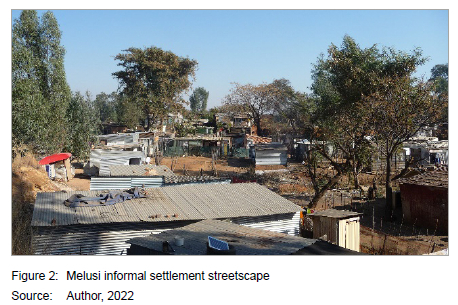
4. MATERIALS AND METHODS
4.1 Research design
This study employed a pragmatic mixed methods research design to evaluate roof-based climate change adaptation strategies aimed at reducing heat stress for residents of informal settlements. By integrating various survey techniques with digital simulation methods and descriptive statistics, the research strives to closely reflect real-world conditions (Denscombe, 2008; Johnson & Onwuegbuzie, 2004). The collected data were analysed descriptively to gain insights into local heat stress exposure (Groat & Wang, 2013; Heumann & Schomaker, 2023). The study focused on the building envelope characteristics such as floors, windows, and walls to inform the digital simulation of two informal dwellings in Melusi, assessing their performance under varying climatic conditions over time. With a quantitative emphasis, the research used the Humidex thermal metric to quantify heat stress exposure and evaluate the effectiveness of the proposed climate change adaptation strategies. While digital modelling and simulation are commonly applied in formal sector assessments (Hugo, Du Plessis & Masenge, 2021; Skelhorn, Levermore & Lindley, 2016), this study adapted these methodologies for informal settings.
4.2 Sample selection
Due to cost and time constraints, the study focused on a smaller sample of dwellings for monitoring. This sample was established using a non-probability convenience sampling method, targeting the area of the informal settlement with the highest built-up density and corrugated iron sheeting buildings, which are particularly vulnerable to heat stress exposure (Kapwata et al., 2018). Initially, fourteen dwellings were selected; however, participant attrition, a rapidly changing built environment, and the challenges of working in informal settlements reduced the number of continuously monitored dwellings to nine (Hugo & Sonnendecker, 2023). A previous study identified similarities in performance and building characteristics, enabling the selection of two representative dwellings (Figures 3 and 4) with limited bioclimatic response measures (Hugo & Sonnendecker, 2023).
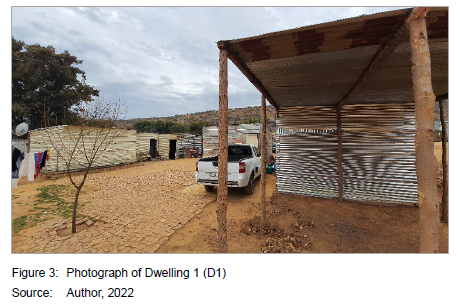
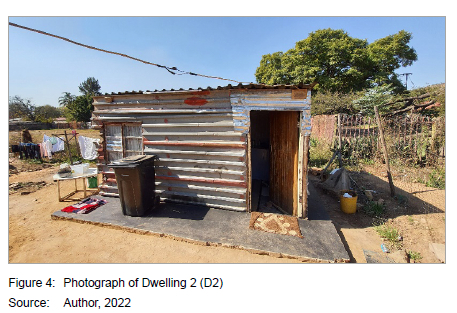
4.3 Data collection to enable simulation verification
To validate the simulations, thermal sensors were installed in May 2021 to continuously monitor the indoor environment, recording ambient air temperature and relative humidity at 15-minute intervals. SSN-22 USB loggers, placed in shared spaces such as kitchens and living rooms at heights between 1000mm-1800mm, offer an accuracy of ±0.3 °C and ±3% for relative humidity. In addition, micro-climatic data were gathered, using a HP200 Wi-Fi weather station located within the settlement, which measures temperature (-30°C to +65°C), humidity (0% to 99%), and wind speeds (up to 30 m/s). Research assistants collected the data from the loggers on a monthly basis when visiting the dwellings.
4.4 Research method: Digital simulation
The simulations were conducted using the Integrated Environmental Solutions Virtual Environment (IESve), an ISO 7730-validated analysis software tool that leverages the EnergyPlus simulation engine to simulate and assess building performance within specific climatic contexts (IES, 2018).
The simulations were conducted using the Integrated Environmental Solutions Virtual Environment (IESve), an ISO 7730-validated analysis tool that leverages the EnergyPlus simulation engine to assess building performance within specific climatic contexts (IES, 2018).
To perform the simulations, the fundamental characteristics of the sample dwellings were documented through observational analysis and a structured survey (Sebake, Breed & Kruger, 2015). This survey captured observable and measurable data related to the buildings' construction, which are critical for evaluating thermal performance. These parameters were then incorporated into the digital model to simulate the dwellings' performance. The simulation models were validated by comparing the collected thermal data with the simulated data using Pearson's R correlation (Table 1) and visual assessments (Skelhorn et al., 2016). A correlation coefficient greater than 0.6 was considered satisfactory for proceeding with subsequent research inquiries (Evans, 1996: 146). The models were adjusted to optimise correlation with empirical data by factoring in aspects such as occupancy patterns, ventilation rates, and infiltration rates. Table 2 provides a brief overview of the simulation model parameters. The models for dwellings D1 and D2 achieved Pearson's R correlation coefficients of 0.72 and 0.91, respectively, during the validation phase (Table 1).
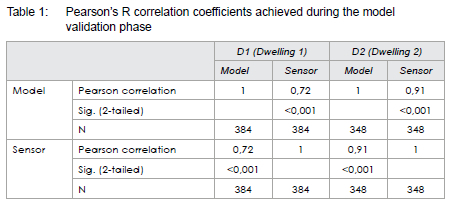
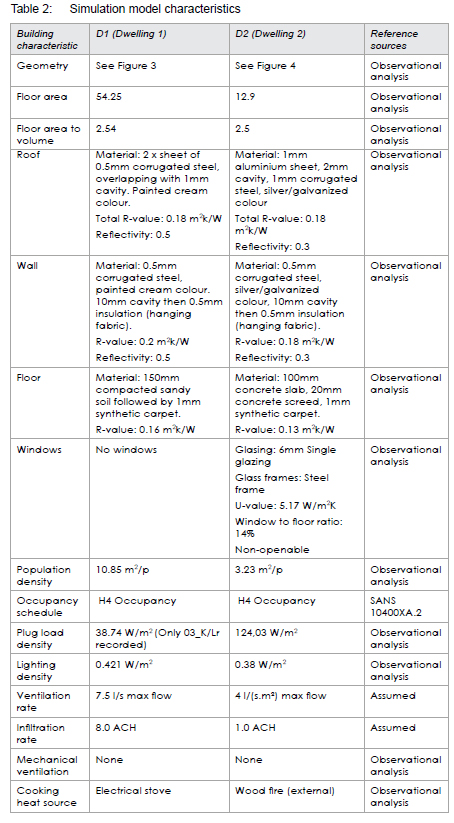
Once verified, the digital models were used to gain an understanding of the user's heat stress exposure within the existing structure; the change in exposure, due to climate change, and to test the various adaptation strategies, in order to assess their efficacy in lowering indoor heat stress exposure.
4.4.1 Simulating current and future climatic conditions
The digital models facilitated simulations of current and future heat stress exposure, as well as potential climate change adaptation measures to mitigate adverse effects on users. These simulations used EnergyPlus weather (EPW) files specific to the Tshwane context, reflecting both current (2022) and projected future climate conditions for 2050 and 2100. Future scenarios were based on the business-as-usual A2 simulation conditions, which predict limited carbon sequestration and thermal increases in South Africa of 4°C -6°C (IPCC, 2000; DEA, 2013). The weather files were instrumental in conducting the simulations and comparing the thermal performance of adaptation strategies across these three time frames.
The simulations relied on EPW files generated by Meteonorm (Meteotest, 2024). The current conditions file was based on actual measurements from the Pretoria Forum Weather Station, located 4km from the research site, serving as a reference for the base weather data. Future weather conditions were synthetically generated according to projected A2 business-as-usual emission scenarios, which anticipate increased atmospheric thermal energy. These models drew from the 2007 IPCC report (Meehl et al., 2007), which provided data on changes in temperature, precipitation, and global radiation for specified periods from 2011 to 2099, forming the basis for the weather files (Meteotest, 2018).
4.4.2 Simulating roof-based climate change adaptation strategies
This study focused on roof-based adaptation strategies for informal dwellings, as the roof has a significant influence on the heat transfer to the interior space in low to mid latitude regions (Conradie, 2017; Folkers & Propst, 2021). As noted in Figure 5 and Table 3, both D1 and D2 experiences the highest levels of solar exposure on their roofs.
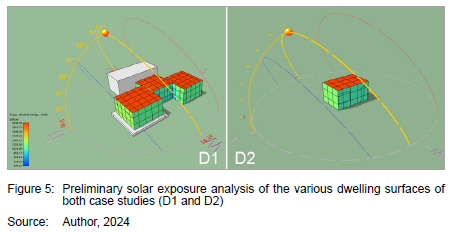
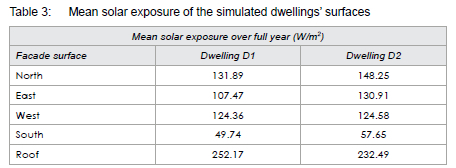
The thermal performance of the various adaptation strategies was quantified, by considering the simulated heat stress exposure and any adjustments to indoor temperatures. The thermal performance was comparatively analysed, using both the original dwelling simulation as well as the four adaptation strategies (Tables 5 and 6). The adaptation strategies are described as follows.
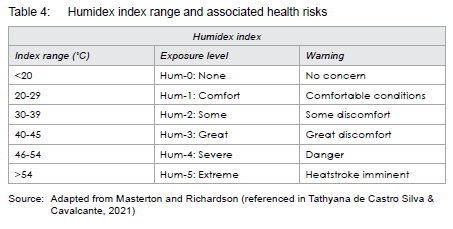
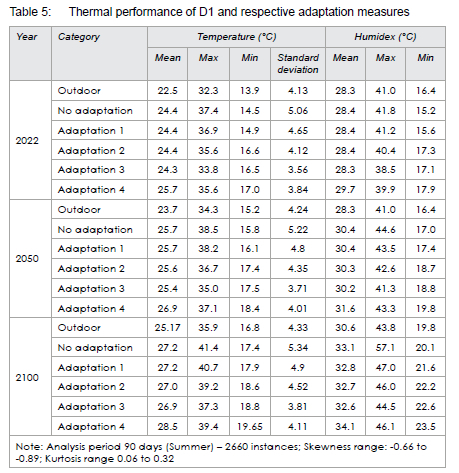
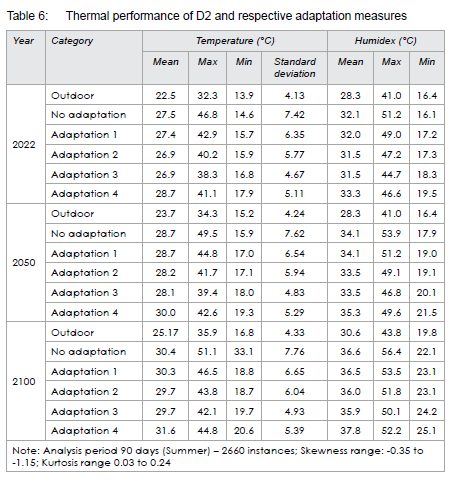
Adaptation 1, based on Propst (2019), involved the use of radiant heat barriers as a response strategy. This adaptation featured a multi-layered, ventilated roof structure, with the innermost layer comprising an infrared light-reflective barrier made of aluminium (Figure 6). This design minimises direct solar heat gain on the roof by shading and reflecting sunlight, thereby limiting the transmission of solar energy into the interior of the structure.
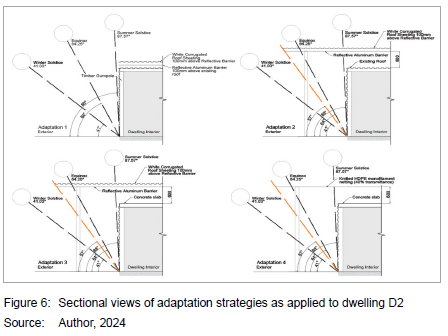
Adaptation 2, as described by Conradie (2017:10), involves an external shading device positioned 600mm above the existing roof structure and extending beyond the dwelling perimeter at a solar angle of 57 degrees (Figure 6). This shading device features a timber frame clad with corrugated iron sheeting and topped with an aluminium infrared barrier. Its primary objective is to reduce solar gains on the dwelling by minimising direct solar exposure (Conradie, 2017). The dimensions and placement of the shading device were informed by solar angles to ensure adequate solar gain during the cooler winter months, while providing shade in the summer.
Adaptation 3 combines elements from adaption strategies 1 and 2, featuring a shading device along with a high thermal mass concrete ceiling (Figure 6). The rationale behind this adaptation is to provide effective shading, while also enhancing thermal mass within the structure. The concrete ceiling is designed to absorb thermal energy during hot days and gradually release that heat during cooler nights, thereby improving comfort both day and night.
Adaptation 4 builds upon the outcomes of Adaptation 3, incorporating a similar high thermal mass ceiling paired with a shading device. This adaptation uses white high-density polyethylene (HDPE) shade netting with a 40% shading factor, positioned above the concrete ceiling. The choice of this lightweight, cost-effective material enhances ventilation in the roof cavity (Figure 6).
4.5 Data analysis and interpretation
The study undertook a descriptive analysis of the simulated data to provide insight into the heat stress exposure experienced in the dwelling interiors. Heat stress exposure within the dwellings was calculated via the Humidex thermal metric (Blazejczyk et al., 2011). These readings were further translated via an associated table of expected correlating health risks, as noted in Table 4.
Humidex calculations were performed for both indoor and outdoor conditions to compare heat stress exposure. In addition, the percentage of indoor heat stress exposure was calculated to quantify the stress experienœd by the dweiling's inhabitants and to evaluate the potential improvements offered by the adaptetion strategies .
Humidex was calculated using local ambient temperatures and saturated vapour pressure (Sirangelo et al., 2020).

Where Ta represents ambient temperature (°C), and e is the partial weter pressure oalculated using using Teten's formula

Where RH represents relative humidity (%) and aimbient temperature (Ta) is used to calculate the saturated water vapour pressure (esat)
4.6 Assumptions, limitations and delimitations
The adaptation measures were tested using two sample dwellings: Dwelling D1, a three-bedroom house occupied by two parents and their three children, and Dwelling D2, a single-room structure housing three adult occupants. While most of the building characteristics could be documented and observed, some parameters such as occupation schedules, infiltration, and ventilation rates could not be accurately measured on-site. Consequently, these were assumed and adjusted to optimise the correlation between the measured and simulated data.
Although the project tested adaptation measures suitable for the informal context, cost, construction feasibility, and construction methods relevant to this context were delimited from the study. While the authors are aware of the construction and resource limitations in informal settlements, the choice to consider implementing a high mass adaptation strategy with lightweight framed structures (predominant typology in informal settlements) was prompted by several studies noting the benefit of double skin roofs (Damoundi et al., 2009; Zingre et al., 2017), and specifically the use of double roof structures with thermal mass, as illustrated in the work of Kere (2012) in resource-scarce built environments.
While the authors acknowledge the importance of improved ventilation for lowering indoor temperatures, this study excluded it from the assessment, due to the limited or non-existent windows in the case studies, particularly in Dwelling D1. Research has widely documented the prevalence of windowless dwellings in informal contexts (Hugo & Sonnendecker, 2023), often attributed to resource constraints and safety concerns. Therefore, the project focused solely on modifying the roofs of typical informal dwellings.
5. RESULTS
This study presents four climate change adaptation strategies aimed at reducing indoor exposure to extreme temperatures. The simulations indicate that the two sample buildings, D1 and D2, perform quite differently in terms of heat stress exposure. The simulated data reflects indoor thermal conditions over a 90-day period during the peak summer months of December to February (Tables 5 and 6).
Under current conditions, Dwelling D1 has a mean temperature of 24.4°C, peaking at a maximum of 37.4°C, while Dwelling D2 experiences a mean temperature of 27.5°C and a maximum temperature of 46.8°C (Tables 5 and 6). Regarding Humidex levels, D1 and D2 present mean values of 28.4°C and 32.1°C, respectively, with maximum humidex conditions reaching 41.88°C for D1 and 51.2°C for D2 (Tables 5 and 6). While the mean humidex conditions are not alarming, the maximum temperatures surpass the thresholds for HUM-3 (great discomfort) and HUM-4 (danger) (Tables 5 and 6).
In terms of future A2 climatic conditions (IPCC, 2000), which anticipate limited climate mitigation efforts, the two dwellings show slightly different performances. Dwelling D1 is projected to experience a 1.3°C increase by 2050 and an additional 2.8°C increase by 2100 (Table 5). By contrast, Dwelling D2 sees a smaller increase of 0.8°C by 2050, followed by a higher increase of 2.9°C by 2100 (Table 6). Notably, D2 is expected to experience a significant rise in maximum indoor temperatures, reaching 49.5°C in 2050 and 51.1°C in 2100 (Table 6). Regarding Humidex conditions, D2 may experience levels between HUM-4 and HUM-5 (with maximum values of 53.9°C in 2050 and 56.4°C in 2100) (Table 6). These findings highlight the urgent need for effective adaptation measures, the efficacy of which is discussed in Section 5.3.
5.1 Dwelling performance under current climatic conditions
The data generated by the simulation models supports the findings of Kapwata et al. (2022) and Naicker et al. (2017), indicating that all indoor conditions of the informal dwellings exhibit increased mean, maximum, and minimum temperatures compared to outdoor conditions.
This increase is not uniform across all three measures, with the most significant differences observed in the maximum temperatures. Dwelling D1 shows a maximum temperature increase of 5.1°C compared to outdoor conditions, while Dwelling D2 experiences a substantial increase of 14 °C (Tables 5 and 6). In addition, the simulated indoor conditions reveal prolonged periods of concerning heat stress exposure. When comparing the two dwellings, D2 spends a higher cumulative time in excessive temperatures categorised as HUM-3 to HUM-4 heat stress conditions, with 17% for D2 versus only 1% for D1 during the summer period (Tables 7 and 8; Figure 7). The simulations further indicate that heat stress exposure within the dwellings is significantly greater than in the surrounding outdoor context, being 1.6 times (D1) to 2.2 times (D2) more intense under HUM-2 (some discomfort) to HUM-4 (danger) conditions (Tables 7 and 8). As a result, residents face a high risk of adverse health complications, due to heat stress exposure, which varies depending on the performance of each dwelling.
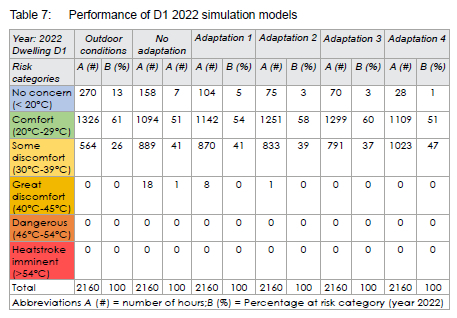
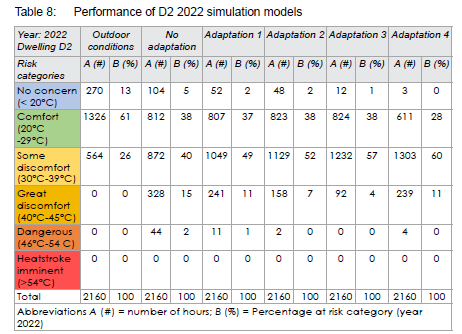
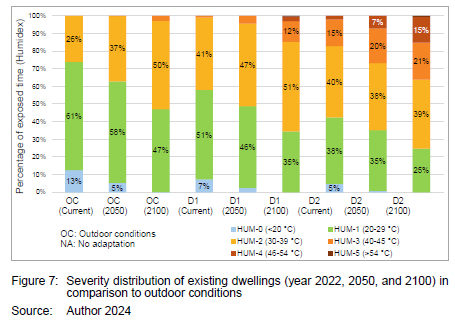
In the unmodified Dwelling D1, 57% of the summer period is spent below the heat stress caution threshold (humidex <29 °C) (Table 7; Figure 7). The highest severity category experienced in this dwelling during the same period is HUM-3 (great discomfort) (Humidex: 40°C-46°C), occurring only 3% of the time (Table 7). This suggests that, under current conditions, residents of Dwelling D1 are expected to face limited excessive heat stress exposure.
By contrast, Dwelling D2 experiences a wider distribution across severity categories during the summer period, with a significant increase in time spent at higher severity levels. Approximately 17% of the time is spent in HUM-3 (great discomfort) to HUM-4 (danger) conditions, with notably 4% of the time in the danger category (Table 8; Figure 7). Residents of D2 are thus at a heightened risk of heat stress exposure, which may lead to greater health complications related to heat stress.
5.2 Dwelling performance under future climate change conditions
The rise in mean ambient temperatures has significant implications for all indoor conditions tested in the simulation models (Tables 5 and 6). For both unmodified dwellings, mean indoor temperatures are projected to increase by 2.9°C between 2022 and 2100. Maximum temperatures are also expected to rise comparably, reaching 41.4°C for Dwelling D1 and 51.1°C for Dwelling D2 by 2100 (Tables 5 and 6). Consequently, the anticipated higher thermal regime by 2100 will result in increased exposure to higher levels of heat stress severity. By that year, Dwelling D1 will subject residents to Humidex 'HUM-3' to 'HUM-4' conditions for 15% of the time, while Dwelling D2 will experience these conditions for 36% of the summer period (Tables 9 and 10). This indicates a significant increase in heat stress exposure for all simulation models under future conditions.
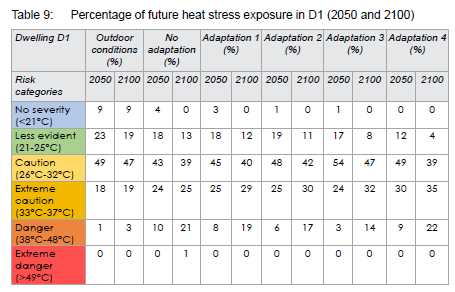
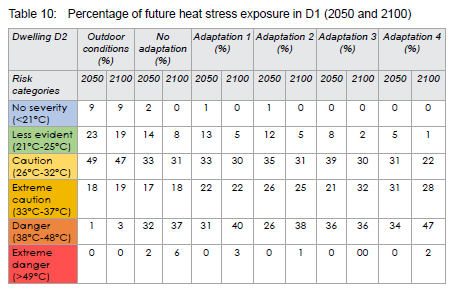
Under outdoor conditions, the percentage of time spent at 'HUM-0' (Humidex <20°C) declines sharply from 2022 to 2100, disappearing entirely during summer months in indoor environments by 2100 (see Tables 9 and 10; Figure 7). Conversely, the time spent in more severe classifications (HUM-3 to HUM-5) significantly increases under projected climate conditions, rising from 1% to 15% in Dwellings D1 and from 17% to 33% in D2. This indicates that climate change is expected to heighten the risk and severity of heat stress-related health issues for occupants in both simulated dwellings, supporting the findings of Garland, Matooane and Engelbrecht (2015). In light of this anticipated increase in heat stress risk, a range of adaptation strategies was simulated. While all tested strategies reduced heat stress exposure within the dwellings, their effectiveness varied (see Figures 8 and 9).
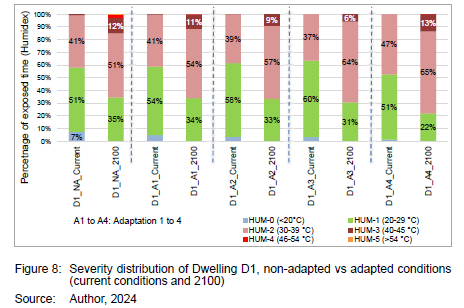
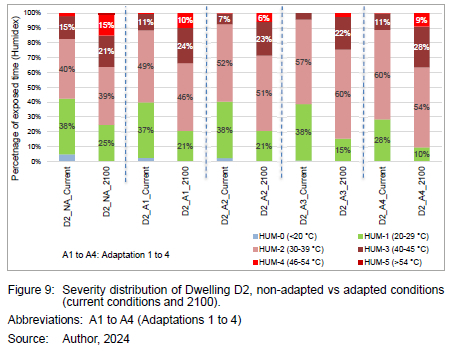
5.3 A comparison of the three climate change adaptation strategies
5.3.1 Adaptation 1
The first adaptation strategy involves a retrofitted multi-layered aluminium sheet with a ventilated gap, effectively eliminating heat stress exposure in the highest severity categories (HUM-3 to HUM-5) for Dwelling D1. In simulations D2, the reduction is less pronounced, achieving a 32% decrease in HUM-3 to HUM-5 conditions (see Tables 7 and 8). This adaptation also slightly lowers maximum temperatures (Tmax), with a reduction of 0.5°C in D1 and 3.9°C in D2 (refer to Tables 5 and 6). For dwelling D1, residents' exposure to HUM-3 to HUM-5 conditions is reduced by 25% in 2050 and 20% in 2100 (Table 9; Figure 8). In dwelling D2, the adaptation similarly decreases heat stress exposure, with reductions of 22% in 2050 and 6% in 2100 (see Figure 9; Table 10).
In both cases, the percentage of time spent in the remaining severity classifications (humidex <29°C) shows a slight increase compared to the original dwelling. For Dwelling D1, there is a 2% increase, while Dwelling D2 experiences a slight decrease of 5% under current conditions (see Tables 7 and 8).
Although the increase in time spent in the 'HUM-2 (some discomfort)' category may seem unfavourable, particularly in Dwelling D2, it results from a decrease in the higher severity classifications. Therefore, this adaptation can be viewed as beneficial for the health of the dwelling's occupants, by reducing exposure to internal heat stress and minimising the risk of heat-related health issues.
5.3.2 Adaptation 2
The Adaptation 2 simulation, featuring a ventilated double roof with an optimised shading device, produced results similar to Adaptation 1. Notably, there was a shift in the distribution of time spent in varying severity categories. Dwelling D2 demonstrated significant improvement under both current and future climatic conditions, with a 41% reduction in time spent under HUM-3 to HUM-5 conditions for the present and a 19% reduction projected for 2100 (see Figure 9; Tables 8 and 10). For current climatic conditions, the reduction in HUM-3 conditions comparing the non-adapted to Adaptation 2 scenarios varied from negligible (1% to 0%) for D1 to more substantial (15% to 7%) for D2 (refer to Tables 7 and 8). This indicates a meaningful transition from dangerous heat stress conditions in D2 to more moderate thermal conditions (see Figure 9; Table 8).
The findings indicate that, under current conditions, Adaptation 2 results in slightly lower maximum temperatures compared to the non-adapted structures (D1: 1.8°C; D2: 6.6°C). However, the reduction is limited when compared to Adaptation 1 (see Tables 5 and 6). Overall, Adaptation 2 performs similarly to Adaptation 1, effectively reducing maximum temperatures that contribute to excessive heat stress, although it does lead to a slight increase in minimum temperatures.
5.3.3 Adaptation 3
Adaptation 3, featuring a retrofitted concrete ceiling and a corrugated steel double roof, significantly reduces heat stress exposure in both dwellings. This is demonstrated by a decrease in maximum temperature values, 3.6°C for dwelling D1 and 8.5°C for dwelling D2, as well as a notable reduction in the time spent in the highest severity categories for dwelling D2, which experiences a 76% decrease in exposure from HUM-2 to HUM-5 (see Figures 8 and 9; Tables 7 and 8). In dwelling D1, the adaptation results in a maximum humidex reduction of approximately 3.3°C compared to the unmodified structure (Table 5). For dwelling D2, the maximum humidex conditions are reduced by 6.5°C under current conditions (Table 6).
Alongside the reduction in heat stress conditions, all tests related to Adaptation 3 indicate an increase in mean and minimum temperatures. Specifically, minimum temperatures rise by 2.0°C in dwelling D1 and 2.2°C in dwelling D2 (see Tables 5 and 6). This increase is likely attributed to the higher thermal mass of the adaptation strategy, which facilitates a gradual release of heat energy stored in the concrete during cooler nighttime and morning periods.
During the summer, the increase in thermal mass has significant implications for heat stress exposure under current conditions. The results indicate a lower percentage of time spent in the HUM-0 to HUM-1 categories, with reductions of 8% for dwelling D1 and 7% for dwelling D2 (see Figures 8 and 9; Tables 7 and 8). Notably, dwelling D2 experiences a 76% decrease in heat stress conditions in the HUM-3 to HUM-5 categories, while dwelling D1 performs even better, showing no heat stress exposure in these higher categories. Analysis of Adaptation 3 reveals that the standard deviations in temperature are significantly lower than in all other tests (Tables 5 and 6), indicating reduced frequency and intensity of temperature variations from the mean. Although Adaptation 3 results in slightly higher mean indoor temperatures (Tamean) compared to other adaptations (D1 Tamean: 0.1-0.3°C increase; D2 Tamean: 0.6-0.7°C increase), the decreased thermal variation, as evidenced by the lower standard deviation, is likely beneficial for residents. Overall, the findings highlight both reduced extreme temperatures and slower thermal variations, facilitating better thermal acclimatisation.
5.3.4 Adaptation 4
Adaptation 4 features an HDPE shade net with a 40% shading factor positioned above a high thermal mass concrete roof retrofitting solution, serving as a lightweight alternative to Adaptation 3. However, within the simulation study, Adaptation 4 offers limited improvements. The 40%shading factor, less than that of Adaptation 3, results in slightly higher maximum temperatures for both dwellings (D1 Tmax: 35.6°C; D2 Tmax: 41.1°C) (see Tables 5 and 6). Consequently, this leads to a 1.6°C increase in indoor temperatures compared to Adaptation 3.
Regarding heat stress exposure, the HUM-3 to HUM-5 conditions are entirely mitigated in dwelling D1, while dwelling D2 shows a 35% reduction in higher heat stress conditions (see Tables 7 and 8). Although the shading netting helps limit excessive temperatures, both dwellings still experience HUM-2 conditions (30°C-39°C) during the summer months, with exposure levels at 47% for D1 and 60% for D2. This represents an increase of 27% for D1 and 5% for D2 compared to baseline conditions (Adaptation 3).
Looking ahead to future scenarios, the 2100 simulations indicate that Adaptation 4 leads to lower maximum temperatures, reducing temperatures by 2°C in D1 and 6.3°C in D2 (see Tables 5 and 6). While both dwellings exhibit similar HUM-3 to HUM-5 heat stress exposure, the severe (HUM-4) and extreme (HUM-5) conditions are significantly reduced, with D1 achieving a 100% reduction and D2 a 40% reduction (see Tables 9 and 10).
In terms of the strategy's efficacy, the study's constraints indicate that a lower shading factor from the shade net results in reduced adaptation success; however, it still contributes to lower indoor temperatures.
6. DISCUSSION AND RELEVANCE TO PRACTICE
The research findings demonstrate the advantages of adapting external roofs for poorly insulated informal dwellings in temperate climates in Southern Africa. Rather than altering the insulative properties of wall materials, the study adopts a pragmatic approach, focusing on external roof applications suitable for existing structures. These adaptations enhance solar control, provide shading, and increase thermal mass, leading to a reduction in heat stress conditions (HUM-3 to HUM-5) by 29%-76% in the worst-performing dwelling (D2) under current climatic conditions, particularly during extreme weather events (see Table 8; Figure 10). This underscores the importance of effective solar control as a strategy for mitigating heat stress in temperate regions at lower to mid latitudes.
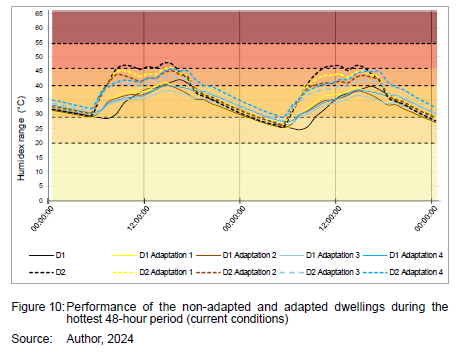
Integrating shading and thermal mass in the third roof-based adaptation measure effectively reduces maximum indoor temperatures by up to 8.5°C. This finding aligns with Kimemia et al. (2020: 33), who reported a 10°C reduction using cool coatings. However, it also addresses their concern about potential over-cooling, as the mean temperature in this adaptation is slightly higher, with a lower standard deviation compared to the first adaptation (which lacks thermal mass) (see Tables 5 and 6).
The study explored the implications of solar control and adequate shading, building on Kolokotroni et al. (2018) regarding cool roof structures. The final application incorporated thermal mass as an external roof feature alongside shading. The findings indicate a continued reduction in heat stress, with the higher thermal mass helping to moderate indoor temperature fluctuations throughout the day. As a result, there are slightly improved indoor thermal conditions and reduced temperature swings. This adaptation strategy offers potential for further development in in-situ upgrades or incremental projects, leading to more comfortable indoor environments and lower heat stress with minimal interventions.
While Adaptation 3 may be criticised for being more carbon-intensive and costly, its application is relevant to current housing solutions that leverage interventions in informal contexts. This approach not only addresses immediate housing needs but also fosters opportunities for change and future growth (Noero Architects, 2024). Adaptation 3 offers a multifaceted solution that serves both as an immediate response to climate change and as a means to support the future development of informal settlements in Southern Africa.
The simulation results from Adaptations 3 and 4 highlight the importance of high thermal mass in temperate regions facing increasing temperatures. While the need to address rising thermal conditions has been recognised for years (Smith, 2010), the predominant focus has been on lightweight framed structures with high thermal insulation. Although such insulation is effective in regulating indoor temperatures, often retaining coolth or heat generated mechanically, high thermal mass offers a viable alternative for adapting to future climate challenges, ensuring more stable thermal transitions. Combining high thermal mass with shading, ventilation, and reflective surfaces can further enhance its benefits (Koloktroni et al., 2018).
Finally, while implementing high thermal mass roofing in informal contexts presents challenges, it highlights the need for further research on optimising this strategy regarding material use and construction methods. One promising alternative is the development of phase-change material panels, which can stabilise indoor temperatures through latent thermal transfer, as demonstrated in the initial work by Ndanduleni, Radebe and Huan (2023). In addition, the advancement of precast concrete panels with higher thermal mass could be advantageous in the future, offering responsive façade applications that enhance thermal performance.
7. CONCLUSION
In response to anticipated climate change and rising temperatures, the article examines potential roof-based adaptation strategies aimed at reducing heat stress for residents of informal dwellings. As highlighted by multiple researchers, understanding the impact of informal built environments on the health and well-being of their inhabitants is crucial (Naicker et al., 2017; Nutkiewics et al., 2022). These studies emphasise the heightened vulnerability of these settlements to increased temperatures. The goal of this research project was to develop effective climate adaptation strategies by retrofitting the roofs of informal dwellings. The effectiveness of these strategies was evaluated primarily in terms of their ability to reduce heat stress exposure, with a strong focus on the implications for residents' health and well-being.
Conclusions are drawn from the performance of the simulated adaptation strategies. Among these, Adaptation 3, incorporating a shading device with a high thermal mass ceiling, demonstrated the greatest net reduction in heat stress exposure. While this strategy proves effective, it also necessitates further research into the optimal use of high thermal mass materials to manage extreme thermal conditions. In terms of feasibility and initial investment, Adaptation 1 emerges as the most effective for reducing heat stress exposure, given its potential for lower costs. This affordability enables broader implementation across communities, enhancing overall climate resilience rather than benefiting isolated individuals. Conversely, Adaptation 3 offers significant long-term advantages, highlighting the need for a future-oriented approach in developing climate change adaptation measures. The results from Adaptation 3 also indicate a need for additional research into using thermal mass as part of heat mitigation strategies.
FUTURE RESEARCH
While the simulations have limitations regarding real-world application and product feasibility, this exploratory article highlights the potential benefits of external roof-based climate change adaptation strategies for temperate regions facing rising temperatures. Future research could focus on developing phase change material panels or high-mass external panels tailored for informal settings, taking into account cost and implementation constraints. As an exploratory study, the findings suggest further development in areas such as solar exposure and improved ventilation to mitigate heat stress.
The authors acknowledge that the current simulation models are constrained in their ability to simulate increased ventilation through thermally driven stack ventilation in high thermal mass roofs (using double roof applications) without prior physical validation of airflow. Future research should involve physical simulations of these double roof structures to optimise this strategy. In addition, exploring the use of more resource-efficient or locally sourced materials can enhance insights into optimising these four strategies by incorporating sustainable practices and appropriate building methods.
ACKNOWLEDGEMENTS
The authors would like to thank all the reviewers for their constructive suggestions to improve the article.
REFERENCES
Ayanlade, A., Esho, O.M., Popoola, K.O., Jeje, O.D. & Orola, B.A. 2019. Thermal condition and heat exposure within buildings: Case study of a tropical city. Case Studies in Thermal Engineering, 14:100477. https://doi.org/10.1016/j.csite.2019.100477 [ Links ]
Baruti, M.M. & Johansson, E. 2020. Urbanites' thermal perception in informal settlements of warm-humid Dar es Salaam, Tanzania. Urban Climate, 31, article 100564. https://doi.org/10.1016/j.uclim.2019.100564 [ Links ]
Bek, M.A., Azmy, N. & Elkafrawy, S. 2018. The effect of unplanned growth of urban areas on heat island phenomena. Ain Shams Engineering Journal, 9, pp. 3169-3177. https://doi.org/10.1016/j.asej.2017.11.001 [ Links ]
Blackhead. 2019. Region 3 - Assessment and categorisation report. Blackhead consulting (BHC/169/02/R2). Pretoria: City of Tshwane. [ Links ]
Blazejczyk, K., Epstein, Y., Jendritzky, G., Staiger, H. & Tinz, B. 2011. Comparison of UTCI to selected thermal indices. International Journal of Biometeorology, 56, pp. 515-535. https://doi.org/10.1007/s00484-011-0453-2 [ Links ]
Blazejczyk, K., Jendritzky, G. & Bröde, P. 2013. An introduction to the Universal Thermal Climate Index (UTCI). Geographia Polonica, 86(1), pp. 5-10. https://doi.org/10.7163/GPol.2013.1 [ Links ]
Brager, G.S. & De Dear, R.J. 1998. Thermal adaptation in the built environment: A literature review. Energy and Building, 27, pp. 83-96. https://doi.org/10.1016/S0378-7788(97)00053-4 [ Links ]
Cherich, M.F. & Wright, C.Y. 2019. Climate change adaptation in South Africa: A case study on the role of the health sector. Globalization and Health, 15(22), pp. 1-16. https://doi.org/10.1186/s12992-019-0466-x [ Links ]
Conradie, D. 2017. Sun and shade. In: The Green Building Handbook South Africa: The Essential Guide. V. 11. Cape Town: Alive2green. [Online]. Available at: https://researchspace.csir.co.za/dspace/bitstream/handle/10204/10030/Conradie_20074_2017.pdf?sequence=1&isAllowed=y [Accessed: 14 August 2022]. [ Links ]
CSIR. 2019. Greenbook: Adapting settlements for the future. [Online]. Available at: https://greenbook.co.za/ [Accessed: 28 August 2022]. [ Links ]
Dabaieh, M., Zakaria, M.M. & Kazem, M. 2021. Stay cool without fossil fuel. A passive eco-cooler for low-income population in informal settlements. Journal of Physics: Conference Series, 2042(1), article 012155. https://doi.org/10.1088/1742-6596/2042/1/012155 [ Links ]
DEA. 2013. Long-Term Adaptation Scenarios Flagship Research Programme (LTAS) for South Africa. Climate trends and scenarios for South Africa. [Online]. Available at: https://www.dffe.gov.za/sites/default/flles/docs/summary_policymakers_bookV3.pdf [Accessed: 15 October 2022]. [ Links ]
Denscombe, M. 2008. Communities of practice. A research paradigm for the mixed methods approach. Journal of Mixed Methods Research, 2(3), pp. 270-283. DOI: https://doi.org/10.1177/1558689808316807 [ Links ]
Dodman, D., Archer, D. & Satterthwaite, D. 2019. Editorial: Responding to climate change in contexts of urban poverty and informality. Environment and Urbanization, 31(1), pp. 3-12. https://doi.org/10.1177/0956247819830004 [ Links ]
Dovey, K. 2015. Sustainable informal settlements? Procedia - Social and Behavioural Sciences, 179, pp. 5-13. https://doi.org/10.1016/j.sbspro.2015.02.406 [ Links ]
Evans, J.D. 1996. Straightforward statistics for the behavioural sciences. Pacific Grove, CA: Brooks/Cole. [ Links ]
Folkers, A. & Propst, D. 2021. Localtalks 01.21 Tropical roofs: Sunshade, rain collector, powerplant and more. [Online]. Available at: https://www.youtube.com/watch?app=desktop&v=EXio5NwlD9k [Accessed: 23 August 2022]. [ Links ]
Garland, R.M., Matooane, M. & Engelbrecht, F.A. 2015. Regional projections of extreme apparent temperature days in Africa and the related potential risk to human health. International Journal of Environmental Research and Public Health, 12, pp. 12577-12604. https://doi.org/10.3390/ijerph121012577 [ Links ]
Groat, L. & Wang, D. 2013. Architectural research methods. 2nd edition. Hoboken, NJ: John Wiley & Sons. [ Links ]
Hernandez-Garcia, J. 2013. Public space in informal settlements: The Barrios of Bogota. Newcastle Upon Tyne: Cambridge Scholars Publishers. [ Links ]
Heumann, C. & Schomaker, M. 2023. Introduction to statistics and data analysis: With exercises, solutions and applications in R. Switzerland: Springer International Publishing. https://doi.org/101007/978-3-031-11833-3 [ Links ]
Hugo, J.M. & Sonnendecker, P.W. 2023. Ground-level documentation of heat stress exposure and response strategies in informal settlements in Tshwane, South Africa. Smart and Sustainable Built Environment. https://doi.org/10.1108/SASBE-10-2022-0229 [ Links ]
Hugo, J., Du Plessis, C. & Masenge, A. 2021. Retrofitting Southern African cities: A call for appropriate rooftop greenhouse designs as climate adaptation strategy. Journal of Cleaner Production, 312, pp. 1-11. https://doi.org/10.1016/j.jclepro.2021.127663 [ Links ]
IES. 2018. Software validation and approval. [Online]. Available at: https://www.iesve.com/software/software-validation [Accessed: 25 October 2023]. [ Links ]
IPCC. 2000. Emissions scenarios. Intergovernmental Panel on Climate Change (IPCC). [Online]. Available at: <https://www.ipcc.ch/report/emissions-scenarios> [Accessed: 22 August 2022]. [ Links ]
IPCC. 2022. Climate Change 2022: Impacts, adaptation and vulnerability. Contribution of Working Group II to the Sixth Assessment Report of the Intergovernmental Panel on Climate Change. Cambridge, UK: Cambridge University Press. https://doi.org/10.1017/9781009325844 [ Links ]
Johnson, R.B. & Onwuegbuzie, A.J. 2004. Mixed methods research: A research paradigm whose time has come. Educational Researcher, 33(7), pp. 14-16. https://doi.org/10.3102/0013189X033007014 [ Links ]
Kapwata, T., Gebreslasie, M.T., Mathee, A. & Yael Wright, C. 2018. Current and potential future seasonal trends of indoor dwelling temperature and likely health risks in rural Southern Africa. International Journal of Environmental Research and Public Health, 15(5), article 952, pp. 1-16. https://doi.org/10.3390/ijerph15050952 [ Links ]
Kere, D.F. 2012. School in Gando, Burkina Faso. Architecturak Design, 82(6), pp. 66-71. https://doi.org/10.1002/ad.1496 [ Links ]
Kimemia, D., Van Niekerk, A., Annegarn, H. & Seedat, M. 2020. Passive cooling for thermal comfort in informal housing. Journal of Energy in Southern Africa, 31(1), pp. 28-39. https://doi.org/10.17159/2413-3051/2020/v31i1a7689 [ Links ]
Kolokotroni, M., Shittu, E., Santos, T., Ramowski, L., Mollard, A., Rowe, K., Wilson, E., Pereira de Brito Filho, J. & Novieto, D. 2018. Cool roofs: High-tech low-cost solution for energy efficiency and thermal comfort in low-rise low-income houses in high solar radiation countries. Energy and Buildings, 176, pp. 58-70. https://doi.org/10.1016/j.enbuild.2018.07.005 [ Links ]
Konstantoglou, M. & Tsangrassoulis, A. 2016. Dynamic operation of daylighting and shading systems: A literature review. Renewable and Sustainable Energy Reviews, 60, pp. 268-283. https://doi.org/10.1016/j.rser.2015.12.246 [ Links ]
Kovats, R.S. & Hajat, S. 2007. Heat stress and public health: A critical review. Annual Review of Public Health, 29, pp. 41-55. https://doi.org/10.1146/annurev.publhealth.29.020907.090843 [ Links ]
Meehl, G.A., et al. 2007. Global climate projections. In: Climate Change 2007: The Physical Science Basis. Contribution of Working Group I to the Fourth Assessment Report of the Intergovernmental Panel on Climate Change, Cambridge University Press, Cambridge, pp. 747-846. [ Links ]
Meng, E., Yang, J., Cai, R., Zhou, B. & Wang, J. 2022. Experimental comparison of summer thermal performance of green roof (GR), double skin roof (DSR) and cool roof (CR) in lightweight rooms in subtropical climate. Journal of Building Physics, 45(6), pp. 809-832. https://doi.org/10.1177/17442591211040545 [ Links ]
Meteotest. 2018. Handbook Part I: Software, Bern: Meteonorm. [Online]. Available at: https://meteonorm.com/en/meteonorm-documents [Accessed: 1 September 2024]. [ Links ]
Meteotest. 2024. Meteonorm features. [Online]. Available at: https://meteonorm.meteotest.ch/en/meteonorm-features [Accessed: 1 September 2024]. [ Links ]
Morton, S., Pencheon, D. & Squires, N. 2017. Sustainable Development Goals (SDGs), and their implementation. British Medical Bulletin, 124(1), pp. 1-10. https://doi.org/10.1093/bmb/ldx031 [ Links ]
Naicker, N., Teare, J., Balakrishna, Y., Wright, C. & Mathee, A. 2017. Indoor temperatures in low-cost housing in Johannesburg, South Africa. International Journal of Environmental Research and Public Health, 14(11), article 1410, pp. 1-18. https://doi.org/10.3390/ijerph14111410 [ Links ]
Ncongwane, K., Botai, J., Sivakumar, V. & Botai, C. 2021. A literature review of the impacts of heat stress on human health across Africa. Sustainability (Switzerland), 13(9), article 5312. https://doi.org/10.3390/su13095312 [ Links ]
Ndalnduleni, A.U.C., Radebe, T.B. & Huan, Z. 2023. Reduction of temperature fluctuations in a South African shack house using phase change material insulation. Building and Environment, 241, article 110376. https://doi.org/10.1016/j.buildenv.2023.110376 [ Links ]
Noero Architects. 2024. The table house. [Online]. Available at: https://www.noeroarchitects.com/project/the-table-house [Accessed: 1 May 2024]. [ Links ]
Nutkiewics, A., Mastrucci, A., Narasimha, R.D. & Rishee, J.K. 2022. Cool roofs can mitigate cooling energy demand for informal settlement dwellers. Renewable and Sustainable Energy Reviews, 159, article 112183. https://doi.org/10.1016/j.rser.2022.112183 [ Links ]
Okyere, S.A. & Kita, M. 2015. Rethinking urban informality and informal settlements growth in urban Africa: A literature discussion. Journal of Sustainable Development in Africa, 17(6), pp. 101-124. [ Links ]
Openstreetmap, 2022. UP COPC - Malusi informal settlement. [Online]. Available at: https://tasks.teachosm.org/projects/1045 [Accessed: 14 August 2024]. [ Links ]
Orazio, M., Perna, C. & Guiseppe, E. 2010. The effects of roof covering on the thermal performance of highly insulated roofs in Mediterranean climates. Energy and Buildings, 42(10), pp. 1619-1627. https://doi.org/10.1016/j.enbuild.2010.04.004 [ Links ]
Orimoloye, I.R., Mazinyo, S.P., Nel, W. & Iortyom, E.T. 2017. Climate variability and heat stress index have increasing potential ill-health and environmental impacts in East London, South Africa. International Journal of Applied Engineering Research, 12(17), pp. 6910-6918. doi.org/t https://www.researchgate.net/publication/319853144. [ Links ]
Pérez-Carramiñana, C., González-Avilés, Á.B., Castilla, N. & Galiano-Garrigós, A. 2024. Influence of sun shading devices on energy efficiency, thermal comfort and lighting comfort in a warm semi-arid dry mediterranean climate. Buildings, 14(2), article 556. https://doi.org/10.3390/buildings14020556 [ Links ]
Pieterse, E. 2011. Grasping the unknowable: Coming to grips with African urbanisms. Social Dynamics, 37(1), pp. 5-23. https://doi.org/10.1080/02533952.2011.569994 [ Links ]
Propst, D. 2019. R&D: Radiant heat and indoor environments. [Online]. Available at: https://emiworld.org/emi-tech/rd-radiant-heat-and-indoor-environments [Accessed: 23 August 2022]. [ Links ]
Santos Nouri, A. & Pedro Costa, J. 2017. Placemaking and climate change adaptation: New qualitative and quantitative considerations for the "Place Diagram". Journal of Urbanism: International Research on Placemaking and Urban Sustainability, 10(3), pp. 356-382. https://doi.org/10.1080/17549175.2017.1295096 [ Links ]
Satterthwaite, D., Archer, D., Colenbrander, S., Dodman, D., Hardoy, J., Mitlin, D. & Patel, S. 2020. Building resilience to climate change in informal settlements. One Earth, 2, pp. 143-156. https://doi.org/10.1016/j.oneear.2020.02.002 [ Links ]
Sebake, M., Breed, I. & Kruger, T. 2015. An assessment of the quality of shared outdoor spaces in three South African social housing complexes. Town And Regional Planning, 66, pp. 1-14. DOI: 10.38140/trp.v66i0.568 [ Links ]
Seto, K.C. & Shepherd, J.M. 2009. Global urban land-use trends and climate impacts. Current Opinion in Environmental Sustainability, 1(1), pp. 89-95. https://doi.org/10.1016/j.cosust.2009.07.012 [ Links ]
Sirangelo, B., Caloiero, T., Coscarelli, R., Ferrari, E. & Fusto, F. 2020. Combining stochastic models of air temperature and vapour pressure for the analysis of the bioclimatic comfort through the Humidex. Scientific Reports, 10(11395), pp. 1-16. https://doi.org/10.1038/s41598-020-68297-4 [ Links ]
Skelhorn, C.P., Levermore, G. & Lindley, S.J. 2016. Impacts on cooling energy consumption due to the UHI and vegetation changes in Manchester, UK. Energy and Buildings, 122, pp. 150-159. https://doi.org/10.1016/j.enbuild.2016.01.035 [ Links ]
Smith, P.F. 2010. Building for a changing climate. The challenge for construction, planning and energy. Oxon: Earthscan. [ Links ]
SolarGIS. 2024. Solar resource maps of South Africa. [Online]. Available at: https://solargis.com/maps-and-gis-data/download/south-africa [Accessed: 1 September 2024]. [ Links ]
StepSA. 2020. Climate indicators Koppen-Geiger climate classifications. [Online]. Available at: http://stepsa.org/climate_koppen_geiger.html [Accessed: 25 April 2024]. [ Links ]
Tathyana de Castro Silva, W. & Cavalcante, G.H. 2021. Spatiotemporal variability of Humidex index over the northeast region of Brazil. Revista Brasileira de Geografía Física, 14(2), pp. 591-606. https://doi.org/10.26848/rbgf.v14.2.p591-606 [ Links ]
Zingre, K.T., Yang, E.H. & Wan, M.P. 2017. Dynamic thermal performance of inclined double-skin roof: Modeling and experimental investigation. Energy, 133, pp. 900-912. https://doi.org/10.1016/j.energy.2017.05.181 [ Links ]
Received: July 2024
Peer reviewed and revised: October 2024
Published: December 2024
* Corresponding author
DECLARATION: The author(s) declared no potential conflicts of interest with respect to the research, authorship, and/or publication of this article.













